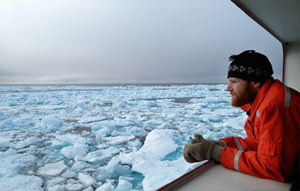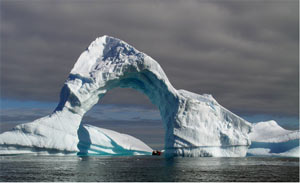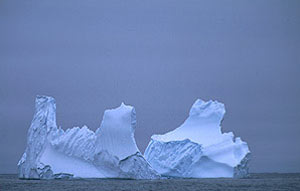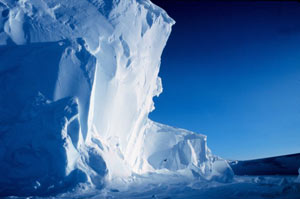Ice

This photo shows melting pack ice, also known as "brash ice," in the Arctic Ocean in summer. Photo by Chris Linder, WHOI.

Erosion has carved an icy arch into this Antarctic iceberg found near Booth Island, Lemaire Channel. Photo by Pat Lohmann, WHOI.

Arctic iceberg in the North Atlantic. Visible portion is the size of a two-storey house. Photo by Chris Linder, WHOI.

The Ross Ice Shelf at the Bay of Whales in Antarctica. This is the southern-most navigable point on the planet and the point where Amundsen started his successful trek to the South Pole. Photo by Michael Van Woert, NOAA.
Ice comes in many forms and shapes. Icebergs, like the one that sank the Titanic, can be as big as a house. Newly formed sea ice, however, can be thin and rubbery like a piece of pizza dough. The Arctic and Antarctic each have both types of ice—read more to learn how they differ.
Glaciers
Although there are many different kinds of ice, it can be divided into two very basic types based on the method of formation. Glacier ice is formed from compacted snow. Thus, they are composed entirely of fresh water. Antarctica, Greenland, and parts of Canada have glaciers. The Antarctic ice sheets are the largest, containing 85% of the world’s ice. Where glaciers meet the sea, the ice can flow out onto the ice, forming a thick, floating ice shelf. Scientists sometimes name these large masses of ice, such as Antarctica’s Larsen B ice shelf. Its rapid disintegration in early 2002 has been attributed to global warming.
Icebergs
Icebergs are chunks of floating ice that have "calved" (broken off) from a glacier. The Greenland ice sheet and the Ellesmere, Devon, and Baffin Island glaciers in Canada account for the vast majority of arctic bergs. Since 90% of an iceberg is below the surface of the water, they travel with ocean currents and not the winds. Most bergs formed in Canada and Greenland stay in the eastern Arctic, eventually being carried into the Atlantic via Davis Strait and melting away. Bergs also form from Antarctic glaciers. Based on their sizes, they are given different names, such as growler and bergy bit.
Pack Ice
The other kind of ice is sea ice, also called pack ice. This kind of ice is formed by the freezing of seawater. Seawater, because of the salt it contains, freezes in a different manner compared to fresh water. The density of seawater steadily increases as it cools, until reaching the freezing point of around -2°C (although this depends on how salty the water is). At the onset of winter, cold air chills the surface waters until a relatively large layer of water at -2°C has formed on the surface. A soupy crystalline mixture known as frazil ice begins to form in the upper layer. As this soup thickens, a thin film of ice known as grease ice forms. This film is strong enough to support the weight of a seabird, and can ripple with the waves passing beneath. As the surface temperature continues to drop, the ice forms a solid layer and is then called pack ice. Ice that forms each winter and melts each summer is known as annual ice, and is usually about six feet thick.
Multi-year ice
In the central Arctic, the ice never thaws completely in summer, and thus it is known as multi-year ice. This ice ranges in thickness from 15 feet to 25 feet. Why doesn't it just keep getting thicker and thicker? Multi-year ice eventually enters equilibrium: the amount of new ice being formed on the bottom of the layer in winter is exactly balanced by the loss due to melting off the top in summer. In Antarctica, sea ice forms in the winter, doubling the area of the continent. In the summer, this ice melts back.

